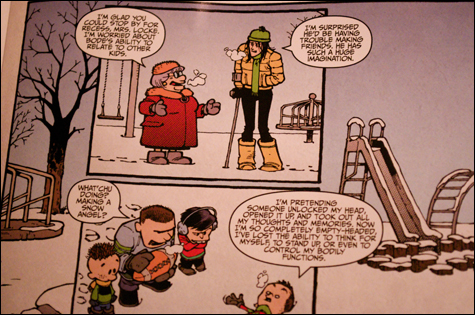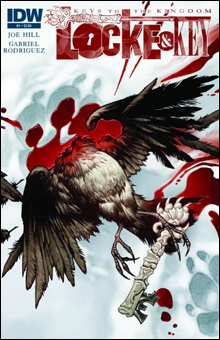
SHIFTING STYLES Artist Gabriel Rodriguez shifts imagery to match the story’s point of view. |
In Joe Hill's second act to his Locke and Key comic-book saga, Keys to the Kingdom, a bloodthirsty wolf pack's feeding frenzy filtered through the youthful lens of Bill Watterson's Calvin and Hobbes comic strip can only be described as disturbing. But it's these details that make the comic, which was dedicated to Watterson, such a satisfying read.
If this is your first time reading Hill's fantasy epic, Locke and Key follows siblings Tyler, Kinsey, and Bode Locke, who, with their friend Dodge, collect mystical keys that can unlock brains, portals to alternate dimensions, and other nifty doors in their small Massachusetts town. Not to spoil anything, but Dodge is a lying bastard, and more importantly, the main villain. Pretending to be their friend, Dodge needs the Locke family to find all the extremely powerful keys, for reasons that are still unclear. And like Hill's antagonists in novels Horns and Heart-Shaped Box, Dodge doesn't mind maiming and killing everyone in his way. But it's hard to expect anything else from the son of Stephen King.
 |
Keys to the Kingdom picks right up where the first act, Crown of Shadows, left off, with the Locke family in possession of the Omega Key, which has the power to unlock the enigmatic Black Door. Rather than bulldoze the overall narrative ahead, and have the Lockes immediately open the black door, Hill is content to sit back and let character development do the heavy lifting. What results is an insightful look into Bode's character, and as mentioned earlier, a classic tribute to the Calvin and Hobbes strip. Bode, the youngest Locke, serves as the issue's Calvin. While he sees the grim situations unfolding around him, he chalks it up as just another fun exercise for the imagination. Hill must have had a stack of Calvin and Hobbes anthologies next to him when he wrote this script, as he channels every last detail of the late comic strip with surprising accuracy. Remember Calvin's species-altering transmogrifier? It's now a key that turns people into the animal they most embody. (For example, Bode, the self-proclaimed loner, turns into a defenseless bird that can only survive within a flock.) By letting the visuals do the talking, the simple statement on Bode's naive innocence is more effective than any bout of dialogue.Speaking of art, artist Gabriel Rodriguez's diverse style elevates Hill's script from a simple homage to a full-blown Bill Watterson love letter. The success is symbiotic, and striking. Most of the story is drawn in a gritty, detailed style. But when the viewpoint shifts to through Calv– I mean, Bode's, the art instantly becomes an homage to Watterson. Rodriguez's style has matured in such a short amount of time, it's hard to believe that he is the same artist who drew the first issue of Locke and Key just two years ago. The panel structure is also worth mentioning: Apart from acclaimed DC Comics illustrator J.H. Williams III, no artist has experimented beyond traditional page layouts like Rodriguez. He might not be as imaginative as Williams, but his breakdowns are far more impressive than anything else on the shelves.